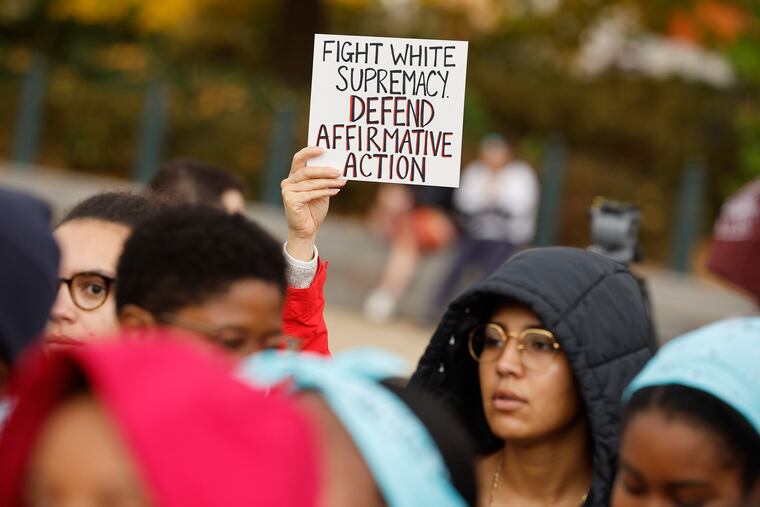The end of affirmative action must not be the end of diversity on college campuses | Editorial
The U.S. Supreme Court’s conservative majority ignores precedent and uses lazy legal logic to set back the march toward justice and racial equality.

The increasingly radical and politicized conservative majority on the U.S. Supreme Court continued their march to impose their narrow political will on the country. On Thursday, they struck down another major legal precedent that impacts the Founding Fathers’ original intent to form a more perfect union.
The court voted 6-3 to overturn a precedent set 45 years ago that allowed colleges and universities to engage in race-based affirmative action. The landmark ruling comes one year after the court voted 6-3 to end nearly 50 years of abortion rights.
In striking down race-based admissions at Harvard University and the University of North Carolina at Chapel Hill, the court made it harder for Black and brown students to gain admission to elite college campuses. For decades, the court ruled that colleges and universities could consider race as part of a holistic review of applicants’ grades, test scores, and extracurricular activities in order to increase the number of students of color.
By overturning two major precedents in little more than one year, the conservative majority on the court dismissed the doctrine known as stare decisis, which in Latin means “to stand by things decided.” After former President Donald Trump stacked the court with three conservative justices, the court’s new mantra seems to be “stare decisis be damned.”
In a powerful dissent, Justice Sonia Sotomayor wrote that it is “a disturbing feature of today’s decision that the court does not even attempt to make the extraordinary showing required” to reverse precedent.
President Joe Biden underscored how the Supreme Court has strayed from its independent role of interpreting the law when he said Thursday: “This is not a normal court.”
Indeed, the conservative majority’s lazy legal logic in the abortion and affirmative action rulings further undermines public trust in the institution. The court’s blatant politicization is especially troubling in light of the influence peddling that has ensnared two of the more strident conservative justices, Clarence Thomas and Samuel Alito, who have failed to report lavish junkets paid for by friends with business before the court. Thomas’ vote to overturn affirmative action is even more striking given that he is a self-acknowledged beneficiary of it.
Diversity has long been one of the greatest strengths of the United States. At the same time, systemic racism remains one of its greatest weaknesses. Affirmative action has been one way to overcome barriers that have prevented Black and brown people from being treated equally under the law, let alone advancing.
More importantly, creating more diverse college campuses benefits all students and society. For many, going away to college may be the first time they meet people from other races, religions, or economic backgrounds. Getting to know one another helps to break down barriers and stereotypes.
As Sotomayor wrote in her 69-page dissent, “Equal educational opportunity is a prerequisite to achieving racial equality in our nation.” Sotomayor, the lone Latina justice, added: “Today, this Court stands in the way and rolls back decades of precedent and momentous progress.”
But Chief Justice John Roberts’ majority opinion claimed the admissions programs at Harvard and UNC “lack sufficiently focused and measurable objectives warranting the use of race, unavoidably employ race in a negative manner, involve racial stereotyping, and lack meaningful end points.”
Sadly, Roberts’ view was no surprise. His previously stated view of affirmative action is: “The way to stop discrimination on the basis of race is to stop discriminating on the basis of race.” Easy for him to say, as a white man who is privileged to lead the nation’s highest court.
Sotomayor needed just a single sentence to dismantle Roberts’ argument: “The court cements a superficial rule of colorblindness as a constitutional principle in an endemically segregated society where race has always mattered and continues to matter.”
As underscored by Justice Ketanji Brown Jackson, the lone Biden nominee on the bench and the first Black woman to serve on the court, “deeming race irrelevant in law does not make it so in life.”
They are right: Race continues to matter in our society.
Truth be told, even with affirmative action, many universities have done a lousy job of increasing Black and brown enrollment. Consider the University of Delaware: In 1983, Black enrollment was 3%. Forty years later, it is around 6% — yet the state’s Black population is 21%.
The challenge now is for colleges and universities to maintain and increase the diversity of students (and faculty) on campus.
One way is to give preference to all students based on household income or zip code. Other steps include expanded recruitment efforts of students who are the first in their families to go to college, eliminating legacy admissions, and dropping early admissions. Increasing the dollar amount of scholarships could make college more affordable for lower-income students.
Nine states, including California, have previously banned consideration of race in admitting students. Yet in 2020, the University of California at Berkeley admitted its most ethnically diverse class in more than 30 years, thanks to a number of steps that included admitting more Pell Grant and California Dream Act applicants.
In Texas, students who graduate in the top 10% of their high school are automatically admitted to the University of Texas.
The Supreme Court’s ruling striking down affirmative action underscores how we are living with a rogue court. But if the march toward justice and equality is to continue, colleges and universities must find other ways to do the right thing.